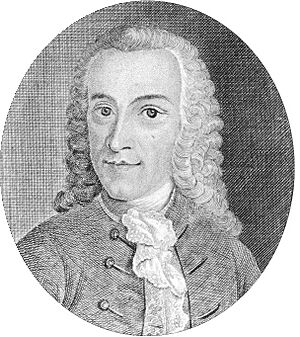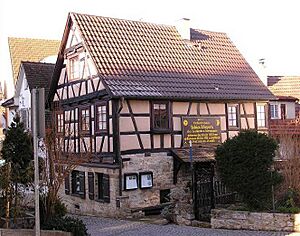Tobias Mayer facts for kids
Quick facts for kids
Tobias Mayer
|
|
|---|---|
 |
|
| Born | 17 February 1723 Marbach am Neckar
|
| Died | 20 February 1762 (aged 39) |
| Nationality | German |
| Scientific career | |
| Fields | Astronomy |
Tobias Mayer (born February 17, 1723 – died February 20, 1762) was a German astronomer. He is most famous for his important studies of the Moon.
Tobias was born in Marbach am Neckar in Germany. He grew up in Esslingen am Neckar and didn't have much money. He taught himself mathematics and earned a living by teaching it when he was still young. He had already published two original math books by 1746. That year, he started working at a mapmaking company in Nuremberg. He made many improvements to mapmaking and became well-known for his scientific skills. Because of this, he was chosen in 1751 to be a professor of economics and mathematics at the University of Göttingen. In 1754, he became the head of the observatory there. He worked at the observatory until he passed away in 1762.
Tobias Mayer's Discoveries and Inventions
Tobias Mayer's first big astronomy project was carefully studying the libration of the Moon. This is how the Moon seems to wobble a little as it orbits Earth. His map of the full Moon, published in 1775, was the best for 50 years!
But he is most famous for his lunar tables. These were special charts that helped predict the Moon's position very accurately. He shared these tables in 1752, along with new charts for the Sun. In 1755, he sent updated versions of these charts to the British government. They were tested and found to be very good. They could help sailors figure out their longitude (their east-west position) at sea to about half a degree. This was a huge help for navigation!
After his death, an improved set of his tables was published in London in 1770. The scientific ideas behind these tables were also published. The British government gave his wife £3,000 because his work was so important.
Mayer also invented the reflecting circle in 1752. This was a tool used to measure angles in the sky very precisely. He also created a formula to correct for atmospheric refraction. This is how light bends when it travels through Earth's air. His formula was very accurate for its time.
Mayer's Lasting Impact
Tobias Mayer left behind many notes and writings. Some of these were collected and published in a book in 1775. This book included an easy way to calculate eclipses. It also had an essay on color, where he recognized three main colors that mix to make all others. He also created a list of 998 stars in the zodiac constellations.
One of his most important papers was about the proper motion of 80 stars. This means how stars appear to move across the sky over many years. This was one of the first truly valuable studies on this topic.
Other notes he left included papers on how Earth's magnetic field works. He tried to explain how the Earth acts like a giant magnet. He made the first real attempt to create a mathematical theory for magnetic action.
Today, there's a lunar crater on the Moon named "T. Mayer" in his honor. It's located southwest of the large Copernicus crater.
Family Life
Tobias Mayer's son, Johann Tobias Mayer, also became a famous German physicist.


